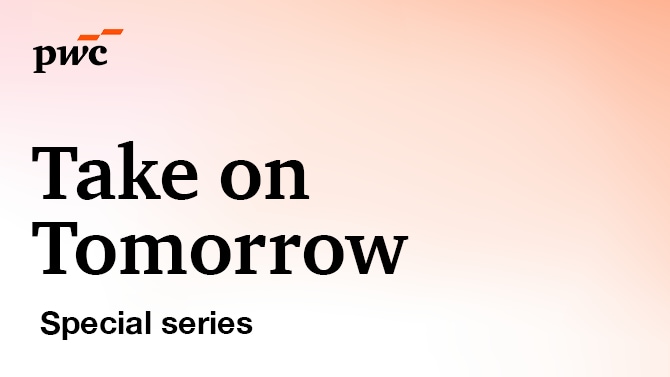**RAFAEL LAGUNA DE LA VERA:**
Government can change law. Government can put a lot of money at stuff, even more than any rich individual could do. Government is actually required to scale businesses.
**FREDERIK BLACHETTA:**
There’s always those kinds of theories, where we argue that governments are the problem. I would really love to see governments change that view and really be innovative drivers.
**RAFAEL LAGUNA DE LA VERA:**
The big questions of our day are global. And it doesn’t really matter all that much who solves them as long as they get solved. The first breakthrough innovation of us is us. You know, we’ve invented a government agency that acts very differently from others.
**LIZZIE O’LEARY:**
Across the world, it’s not just the private sector seeing an opportunity for innovative growth. Governments are also stepping into the fold—helping to accelerate big ideas across industries, fostering new kinds of partnerships, and improving lives.
**FEMI OKE:**
So could the world’s next big breakthrough innovation be driven by government?
**LIZZIE O’LEARY:**
And what does that mean for the way the public and private sector work together?
**FEMI OKE:**
I’m Femi Oke, a broadcaster and journalist.
**LIZZIE O’LEARY:**
And I’m Lizzie O’Leary, a podcaster and journalist. This is a special series of *Take on Tomorrow*, the podcast from PwC’s management publication, *Strategy and Business*.
**FEMI OKE:**
Today, we ask: what’s the role of government in driving innovation, as we look at how we Govern and Serve?
**LIZZIE O’LEARY:**
To help us understand how the relationship between business and government works today—and could work in the future—we’re delighted to be joined by Frederik Blachetta, Public Sector Data & AI Leader from PwC Germany. Frederik, welcome to the show!
**FREDERIK BLACHETTA:**
Nice to be here.
—
### Why Governments Matter in Innovation
**FEMI OKE:**
We talk a lot about the role of businesses in driving innovation, but why should we be paying attention to what governments do in this space?
**FREDERIK BLACHETTA:**
There are several reasons. Looking into history, many groundbreaking innovations that we benefit from—like the smartphone with haptic touch—would not have been possible without government funding and risk-taking.
Governments often close the early-stage risk gap that private investors cannot or will not take on. This is especially true for complex endeavors that have uncertain outcomes or long timelines.
—
### Government and Business: A Shifting Relationship
**LIZZIE O’LEARY:**
Before joining PwC, you worked inside government at the German Federal Chancellery. How has government traditionally worked alongside businesses? And are we seeing a shift now?
**FREDERIK BLACHETTA:**
It’s important to counter the narrative that governments are inherently slow. That can also be said of some large corporations, which have their own complexities.
People who work in government often have a mission to improve society. Traditionally, governments tried to do everything themselves, but now there’s a trend toward capability-driven ecosystems. This means thinner barriers and more cooperation with private sector partners.
Governments are learning what they can adopt from private companies to improve public services. This cooperation is essential.
—
### Spotlight on SPRIND: Germany’s Innovation Accelerator
**FEMI OKE:**
The German government created SPRIND in 2019 to boost breakthrough innovations addressing social and economic challenges. Rafael Laguna de la Vera, the agency’s director, explains:
**RAFAEL LAGUNA DE LA VERA:**
Germany does excellent basic research but hasn’t translated that into new industries as much recently. Innovations often emerge from the U.S. or China.
We face a “valley of death” after basic research, especially in deep tech, where projects need significant funding before reaching the market. Private investors frequently can’t or won’t support such long timelines or high risk—like a fusion power plant that might take 15-20 years.
SPRIND bridges that gap.
—
### How SPRIND Works With Businesses
**FEMI OKE:**
How do you engage with businesses?
**RAFAEL LAGUNA DE LA VERA:**
We use several criteria to identify high-potential teams—whom we call HiPos—with grit and vision.
Each year, during “Venture SPRIND,” 300-400 investors, family offices, and industry players attend while about 50 teams pitch innovations, showcasing their potential. This connects innovators with industry investors.
Once projects attract enough private sector interest and funding, SPRIND steps back.
—
### Knowing When to Step Away
**FEMI OKE:**
How do you know the right moment to leave projects?
**RAFAEL LAGUNA DE LA VERA:**
We monitor whether they have secured sufficient private funding. When we can see that in their wallets, we step aside—no need to spend tax money if the private sector is ready to carry the project.
—
### Government Uniqueness in Innovation
**FEMI OKE:**
What can government do uniquely compared to industry alone?
**RAFAEL LAGUNA DE LA VERA:**
Government can change laws and invest significantly—even more than wealthy individuals. Governments are required to scale businesses but need to orchestrate the process better. We’re still improving in that area.
—
### SPRIND’s Limitations
**FEMI OKE:**
What are SPRIND’s limitations?
**RAFAEL LAGUNA DE LA VERA:**
As a government agency, we have strict rules to navigate. We passed the “SPRIND Liberty Law” in late 2023 to operate differently.
Budget is always a constraint—whether we have enough funds to support projects until the private sector can take over.
Also, international collaboration is challenging but vital.
—
### Success Stories from SPRIND
**FEMI OKE:**
Can you share some successful projects?
**RAFAEL LAGUNA DE LA VERA:**
We’ve supported over 250 projects, including:
– The world’s tallest wind generator (300 meters high) producing more stable energy.
– Potential cures for Alzheimer’s and various cancers.
– Water cleaning innovations targeting microplastics.
– CO₂ removal via ocean algae.
Science has continuously improved living standards, and there’s no end to innovation if we apply and scale it effectively.
—
### Ethical Responsibility in Innovation
**FEMI OKE:**
Are you funding innovations purely for their societal good?
**RAFAEL LAGUNA DE LA VERA:**
Yes, because we spend taxpayers’ money. We avoid funding projects that benefit only a few or create monopolies that are harmful to society. Our work is grounded in humanistic values.
—
### Collaborating With the Private Sector
**FEMI OKE:**
How does the collaboration with private sector evolve?
**RAFAEL LAGUNA DE LA VERA:**
In early phases, it might involve charities or other government bodies due to high risk and lack of economic value. As projects mature, we engage relevant industries.
For example, in Alzheimer’s treatment development, we fund phase two clinical trials (~€90 million), while pharmaceutical companies must finance the more expensive phase three.
We start dialogues years in advance to ensure funding and partnerships when projects are ready for scale.
—
### Addressing Basic Human Needs Through Innovation
**FEMI OKE:**
How are SPRIND’s supported innovations addressing fundamental human needs like mobility, health, energy, or food?
**RAFAEL LAGUNA DE LA VERA:**
Energy is foundational—abundant, clean, and cheap energy can solve many problems, from water scarcity to food production.
That’s why we focus on nuclear fusion, massive wind generators, and long-term, recyclable energy storage solutions to address renewable energy intermittency.
Science is key to solving these challenges, but it requires application and scale.
—
### Can Other Countries Replicate SPRIND?
**FEMI OKE:**
Could other countries adopt the SPRIND model?
**RAFAEL LAGUNA DE LA VERA:**
We consider ourselves an open-source agency. The big challenges are global; who solves them matters less than that they’re solved.
Having many SPRIND-like agencies worldwide working collaboratively, and governments operating differently, would be ideal. Our approach itself is an innovation in government operations.
—
### The Power of Global Collaboration
**FEMI OKE:**
If every country had agencies like SPRIND collaborating globally, what could society achieve?
**RAFAEL LAGUNA DE LA VERA:**
Take longevity—people want long, healthy lives. This raises societal questions about wealth creation and distribution.
With orchestrated innovation agencies ensuring benefits reach all, rather than a few monopolies, society could enjoy abundant resources like clean energy, food, and water, enabling freer lives not solely driven by economic needs.
Such agencies could be a crucial step toward that future.
—
### Frederik Reflects on Government-Business Partnerships
**LIZZIE O’LEARY:**
Frederik, SPRIND is one example. Are there other effective government-business partnerships?
**FREDERIK BLACHETTA:**
Yes. For example, the European Union has innovation partnerships tackling problems with uncertain solutions.
User-centricity is vital, especially in digital and AI spaces, where pilot projects and acceptable failures lead to breakthroughs.
Governments must openly share their challenges and prioritize using technology for societal good, supported by leadership at top levels.
—
### The Role of Technology in Government Innovation
**LIZZIE O’LEARY:**
How important is disruptive technology in driving innovation?
**FREDERIK BLACHETTA:**
Extremely important. Currently, many Western governments lag behind private experience in technology.
We must embrace disruptive tech, accept failures as learning opportunities, and apply portfolio approaches to find successful innovations capable of solving large problems.
—
### Supporting Innovation in Developing Countries
**FEMI OKE:**
What about governments in developing countries with fewer resources?
**FREDERIK BLACHETTA:**
It’s critical to develop and share accessible disruptive technologies globally.
For instance, the United Nations promotes open-source AI to avoid technology becoming a divider and instead serve as an enabler for everyone.
—
### Frederik’s Vision for the Future
**LIZZIE O’LEARY:**
What’s your vision for the world in ten years if we get innovation and government support right?
**FREDERIK BLACHETTA:**
A key milestone would be renewed trust in governments’ handling of technology and partnerships.
The ideal, a “moonshot,” would be bipartisan agreement on the benefits of multi-stakeholder collaboration, strengthening public-private partnerships.
This would improve society’s well-being and how we coexist.
—
### Final Thoughts
**FEMI OKE:**
Rafael, Frederik, thank you both for your insights.
**FEMI OKE:**
I’ve learned that governments, with the right mindset, can spark innovations that might never survive otherwise.
**LIZZIE O’LEARY:**
And the strength lies in partnership—leveraging each sector’s unique capabilities to better society.
—
For more episodes and information, visit [pwc.com/takeontomorrow](https://www.pwc.com/takeontomorrow).
*Take on Tomorrow* is brought to you by PwC’s *Strategy and Business* publication. Follow us wherever you get your podcasts.
https://pwc.to/4oKbp5O?rssid=all_updates

